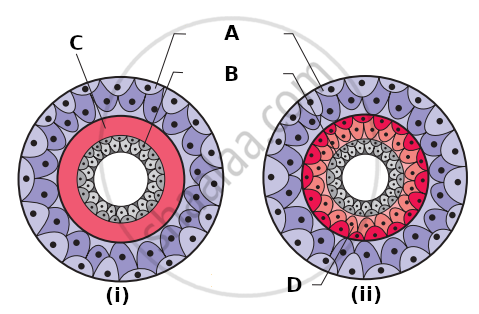Advertisements
Advertisements
Question
Match the following list of animals with their level of organisation.
| Division of Labour | Animal |
| Column I | Column II |
| A. Organ level | i. Pheretima |
| B. Cellular aggregate level | ii. Fasciola |
| C. Tissue level | ii. Spongilla |
| D. Organ system level | iv. Obelia |
Choose the correct match showing division of labour with animal example.
Options
i - B, ii - C, iii - D, and iv - A
i - B, ii - D, iii - C, and iv - A
i - D, ii - A, iii - B, and iv - C
i - A, ii - D, iii - C, and iv - B
Solution
i - D, ii - A, iii - B, and iv - C
Explanation:
| Division of Labour | Animal |
| Column I | Column II |
| A. Organ level | ii. Fasciola |
| B. Cellular aggregate level | iii. Spongilla |
| C. Tissue level | iv. Obelia |
| D. Organ system level | i. Pheretima |
APPEARS IN
RELATED QUESTIONS
What are the reasons that you can think of for the arthropods to constitute the largest group of the animal kingdom?
Complete the following chart.
| Body cavity | Germ Layer | Phylum |
| Absent | ______ | Porifera |
| Absent | Triploblastic | ______ |
| Pseudocoelom | ______ | Aschelminthes |
| Present | ______ | Arthropoda |
Draw a neat and labelled diagram.
Jellyfish
The largest division of the living world is ______.
Species is the ______ unit of classification.
Compare Schizocoelom with enterocoelom.
In which of the following the notochord is present only in embryonic stages?
Examine the figures of diploblastic (i) and triploblastic (ii) organization in animals given below and identify the labelled parts A to D.

Complete the paragraph using proper words:
(Asymmetrical, Paramecium, Equal, imaginary, central, insects, rats, bird, three, unequal)
If body of any animal is cut through ______ axis of body, it may or may not produce two equal halves. Depending upon this property, there are different types of animal bodies. In the case of ______ body, there is no any such imaginary axis of the body through which we can get two equal halves. For example Amoeba, ______ some sponges. In radial symmetry type of body, if imaginary cut passes through central axis but any plane of body, it gives two ______ halves. For example Starfish. In case of this animal, there are five different planes passing through ______ axis of body through which we can get two equal halves. In Bilateral symmetry type of body, there is only one such imaginary axis of body through which we can get two equal halves. For example: ______ fishes, frog, birds, human, etc.
Animal with bilateral symmetry in ______.
